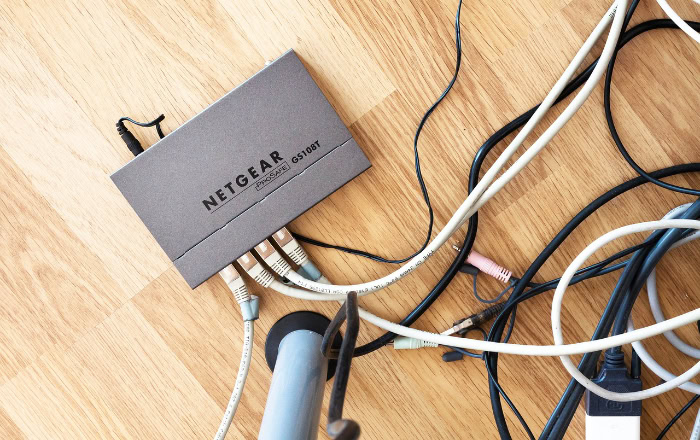MAC Spoofing: Digital Disguise or Security Threat?

Network security is a critical aspect of our interconnected world, and MAC addresses play a vital role in this ecosystem. These unique identifiers, assigned to network interface cards, form the foundation of data transmission across local networks.
However, the ability to alter these addresses through a process known as MAC spoofing has significant implications for both network administrators and potential attackers. This article examines the concept of MAC spoofing, its technical underpinnings, and its impact on network security.
Understanding MAC Addresses
Media Access Control (MAC) addresses are fundamental components of network communication. These unique identifiers play a crucial role in how devices interact within local networks.
What Are MAC Addresses?
A MAC address is a 12-digit hexadecimal number assigned to each network interface card (NIC) by its manufacturer. This address serves as a unique identifier for the device on a network.
MAC addresses are also known as physical addresses or hardware addresses because they are directly tied to the network hardware.
The primary purpose of MAC addresses is to facilitate communication between devices on the same local network. They ensure that data packets reach their intended destination by providing a reliable way to identify specific devices.
This is particularly important in environments where multiple devices share the same network infrastructure.
Network Communication and MAC Addresses
MAC addresses operate at the data link layer of the OSI model, which is responsible for reliable data transfer between adjacent network nodes. When a device wants to send data to another device on the same network, it uses the recipient's MAC address to ensure the data reaches the correct destination.
The process works as follows:
- The sending device encapsulates the data in a frame, which includes the source and destination MAC addresses.
- The frame is sent out onto the network.
- Network switches use the destination MAC address to forward the frame to the appropriate port.
- The receiving device checks the destination MAC address in the frame. If it matches its own MAC address, it processes the data; otherwise, it discards the frame.
This system allows for efficient communication within local networks, as devices can directly address each other without the need for complex routing.
MAC Addresses vs. IP Addresses
While both MAC addresses and IP addresses are used in network communication, they serve different purposes and operate at different levels of the network stack.
MAC addresses are:
- Assigned by hardware manufacturers
- Unique to each network interface
- Used for communication within local networks
- Typically unchangeable (though they can be spoofed)
- Operate at the data link layer of the OSI model
IP addresses, on the other hand, are:
- Assigned by network administrators or DHCP servers
- Can be changed as needed
- Used for communication across different networks
- Operate at the network layer of the OSI model
- Can be either static or dynamic
In practice, both MAC and IP addresses work together to ensure data reaches its intended destination. The Address Resolution Protocol (ARP) bridges the gap between these two addressing systems, allowing devices to map IP addresses to MAC addresses within a local network.
What is MAC Spoofing?

MAC spoofing is a technique used to alter the Media Access Control (MAC) address of a network interface. This practice has various applications, both legitimate and malicious, and can significantly impact network security.
Defining MAC Spoofing
MAC spoofing refers to the act of changing the factory-assigned MAC address of a network interface to a different address. This process involves modifying the MAC address that's visible to the network, effectively masking the true identity of the device.
By altering this unique identifier, users can potentially bypass certain network restrictions, enhance privacy, or impersonate other devices on the network.
It's important to note that MAC spoofing doesn't permanently alter the physical address burned into the network interface card. Instead, it temporarily changes the MAC address that the operating system uses and broadcasts to the network.
This modification persists until the device is rebooted or the network interface is reset.
The Technical Process
Changing a MAC address involves manipulating the operating system's network configuration. The process typically follows these steps:
First, the user or a program identifies the current MAC address of the network interface. This information is usually available through the operating system's network settings or command-line tools.
Next, the network interface is disabled. This step is crucial as it prevents conflicts that might arise from changing the MAC address while the interface is active.
Then, a new MAC address is generated or selected. This can be done randomly or with a specific address in mind, depending on the user's goals.
The operating system's network configuration is then updated with the new MAC address. This step often requires administrative privileges, as it involves modifying system-level settings.
Finally, the network interface is re-enabled, and the device begins using the new MAC address for all network communications.
Common Spoofing Methods
There are several methods used to spoof MAC addresses, varying in complexity and the level of control they offer. Here are some of the most common approaches:
Command-line tools: Many operating systems provide built-in commands to change MAC addresses. For example, on Linux systems, the “ifconfig” or “ip” commands can be used, while Windows users might employ the “netsh” command.
Third-party software: Numerous applications are available that simplify the process of MAC spoofing. These tools often provide user-friendly interfaces and additional features like MAC address generation or scheduling of address changes.
Driver-level modifications: Some advanced users may opt to modify network driver settings directly. This method offers more persistent changes but requires a deeper understanding of system architecture.
Hardware-based spoofing: In rare cases, specialized hardware devices can be used to spoof MAC addresses at the physical layer. This method is less common but can be more difficult to detect.
Scripting and automation: For users who need to change MAC addresses frequently or across multiple devices, custom scripts can automate the process. This approach is particularly useful in testing or research environments.
Reasons for MAC Spoofing

MAC spoofing is a technique that has various applications, ranging from legitimate network management tasks to potentially malicious activities. While the practice can raise security concerns, it's important to recognize that there are valid reasons for changing a device's MAC address.
Network Testing and Troubleshooting
Network administrators and security professionals often employ MAC spoofing as a tool for testing and troubleshooting network configurations. This practice allows them to simulate different scenarios and verify the effectiveness of security measures without the need for additional hardware.
For instance, when setting up MAC address filtering on a network, administrators might spoof various MAC addresses to ensure that only authorized devices can connect. This helps in identifying potential vulnerabilities and fine-tuning access controls.
Another common use is in load testing. By spoofing multiple MAC addresses from a single device, testers can simulate numerous connections to a network or server, helping to assess its performance under high-traffic conditions.
MAC spoofing also plays a role in diagnosing network issues. If a specific device is experiencing connectivity problems, an administrator might temporarily assign it the MAC address of a known working device to isolate the source of the problem.
Privacy and Anonymity
In an era of increasing digital surveillance, some individuals turn to MAC spoofing as a means of enhancing their privacy and anonymity online. While not a foolproof method, changing one's MAC address can make it more difficult for network operators to track specific devices.
Public Wi-Fi networks, for example, often use MAC addresses to identify and sometimes track users. By periodically changing their MAC address, users can limit the amount of data that can be associated with their device over time.
Some operating systems, recognizing these privacy concerns, have implemented features that automatically generate random MAC addresses when connecting to new networks. This built-in functionality aims to reduce the risk of long-term tracking based on a device's MAC address.
It's worth noting that while MAC spoofing can enhance privacy at the local network level, it doesn't provide complete anonymity. Other identifying factors, such as IP addresses and browser fingerprints, can still be used to track online activities.
Bypassing Network Restrictions
One of the more controversial uses of MAC spoofing is to circumvent network restrictions or access controls. Many networks use MAC address filtering as a security measure, allowing only devices with specific MAC addresses to connect.
By spoofing an authorized MAC address, users can potentially gain access to networks they're not supposed to use. This could include accessing restricted Wi-Fi networks or bypassing time limits on public internet access points.
In some cases, MAC spoofing is used to overcome limitations imposed by internet service providers. For example, some ISPs may limit the number of devices that can connect to the internet simultaneously.
By changing a device's MAC address to match an already authorized device, users might bypass these restrictions.
It's crucial to emphasize that while MAC spoofing can be used for these purposes, doing so may violate network policies or terms of service. In some jurisdictions, unauthorized access to networks through MAC spoofing could even be considered illegal.
Security Implications of MAC Spoofing

While MAC spoofing has legitimate uses, it also presents significant security risks when employed maliciously. The ability to alter a device's MAC address can be exploited by attackers to gain unauthorized access to networks, intercept data, and evade security measures.
Unauthorized Network Access
One of the most concerning aspects of MAC spoofing is its potential to facilitate unauthorized network access. Many networks rely on MAC address filtering as a security measure, allowing only devices with specific MAC addresses to connect.
However, this approach becomes vulnerable when an attacker can spoof an authorized MAC address.
By impersonating a legitimate device, an attacker can bypass initial access controls and connect to a restricted network. Once connected, they may attempt to exploit other vulnerabilities or launch further attacks from within the network.
This is particularly dangerous in corporate or government environments where network access often equates to access to sensitive information.
Moreover, some networks use MAC addresses for accounting and billing purposes, especially in public Wi-Fi hotspots or internet cafes. An attacker could potentially use a spoofed MAC address to gain free access or charge their usage to another user's account.
The risk of unauthorized access highlights the importance of implementing multiple layers of security beyond MAC address filtering. Strong encryption, robust authentication protocols, and continuous network monitoring are essential to mitigate these risks.
Man-in-the-Middle Attacks and Data Interception
MAC spoofing can be a precursor to more sophisticated attacks, particularly man-in-the-middle (MITM) attacks. In an MITM attack, the attacker positions themselves between two communicating parties, intercepting and potentially altering the data exchanged between them.
By spoofing the MAC address of a trusted network device, such as a router or switch, an attacker can redirect network traffic through their own device. This allows them to capture and analyze the data passing through, potentially exposing sensitive information like login credentials, financial data, or confidential communications.
For example, an attacker might spoof the MAC address of a legitimate Wi-Fi access point. Unsuspecting users connecting to this fake access point would then route all their traffic through the attacker's device, allowing for easy interception and manipulation of data.
The risk of data interception through MAC spoofing emphasizes the need for end-to-end encryption in network communications. Protocols like HTTPS for web traffic and VPNs for general network access can help protect data even if an attacker manages to intercept it.
MAC Address Filtering Evasion
MAC address filtering is a common security measure used in both home and enterprise networks. It involves configuring network devices to allow connections only from a list of approved MAC addresses.
While this can provide a basic level of access control, MAC spoofing significantly undermines its effectiveness.
An attacker who has obtained the MAC address of an authorized device can easily spoof that address to bypass the filter. This can be particularly problematic in environments where MAC filtering is relied upon as a primary security measure, such as in some home networks or small businesses.
Furthermore, the evasion of MAC filtering through spoofing can complicate network troubleshooting and security auditing. It becomes challenging to accurately track and manage network access when devices can easily masquerade as one another.
To address this vulnerability, network administrators must recognize that MAC address filtering should be considered only as one component of a broader security strategy. Implementing additional authentication methods, such as WPA3 for Wi-Fi networks or 802.1X for wired networks, can provide more robust protection against unauthorized access attempts.
Detection and Prevention Measures
As MAC spoofing poses significant security risks, it's crucial for network administrators and security professionals to implement effective detection and prevention measures.
Network Monitoring and Intrusion Detection Systems
Network monitoring and intrusion detection systems (IDS) play a vital role in identifying and mitigating MAC spoofing attempts. These tools continuously analyze network traffic patterns and device behaviors to detect anomalies that might indicate spoofing activities.
Advanced network monitoring solutions can track MAC address changes and flag suspicious activities. For instance, if a device suddenly appears on the network with a MAC address that was previously associated with a different device, the system can generate an alert for further investigation.
Intrusion detection systems employ various techniques to identify potential MAC spoofing. Some IDS solutions use machine learning algorithms to establish baseline network behavior and detect deviations that could signify spoofing attempts.
Others rely on signature-based detection, comparing network activities against known patterns of MAC spoofing attacks.
Network administrators can also implement tools that track the manufacturer information embedded in MAC addresses. If a device claims to have a MAC address associated with one manufacturer but exhibits characteristics of a different manufacturer's hardware, it could indicate spoofing.
Real-time alerting is a crucial feature of these systems. When potential spoofing is detected, immediate notifications allow administrators to respond quickly, potentially preventing unauthorized access or data breaches.
MAC Address Authentication Protocols
To combat the vulnerabilities of simple MAC address filtering, more robust authentication protocols have been developed. These protocols go beyond merely checking the MAC address and incorporate additional layers of verification.
One such protocol is IEEE 802.1X, which provides port-based network access control. This standard requires devices to authenticate themselves before they can access the network.
Even if an attacker spoofs a MAC address, they would still need to provide valid credentials to gain network access.
Another approach is the use of dynamic MAC address management systems. These systems regularly change the allowed MAC addresses on the network, making it more difficult for attackers to use spoofed addresses effectively.
Some networks implement a combination of MAC and IP address binding. This technique associates specific MAC addresses with particular IP addresses, adding an extra layer of verification.
If a device tries to use an IP address that doesn't match its registered MAC address, the network can block the connection.
For wireless networks, protocols like WPA3 (Wi-Fi Protected Access 3) offer enhanced security features that can help mitigate the risks of MAC spoofing. These protocols use more sophisticated encryption and authentication methods, making it much harder for attackers to gain unauthorized access even if they manage to spoof a MAC address.
Best Practices for Network Administrators
Network administrators can implement several best practices to reduce the risk of MAC spoofing and enhance overall network security:
Implement strong authentication methods: Use multi-factor authentication wherever possible, especially for accessing critical network resources. This ensures that even if a MAC address is spoofed, additional verification is required.
Regularly update and patch systems: Keep all network devices, including routers, switches, and firewalls, up to date with the latest security patches. This helps protect against known vulnerabilities that could be exploited in conjunction with MAC spoofing.
Segment networks: Divide the network into separate VLANs (Virtual Local Area Networks) to limit the potential impact of a successful spoofing attack. This can contain the breach to a smaller section of the network.
Use encryption: Implement strong encryption protocols for all network communications. This ensures that even if data is intercepted through MAC spoofing, it remains unreadable to the attacker.
Conduct regular security audits: Perform periodic assessments of network security measures, including testing for MAC spoofing vulnerabilities. This can help identify and address potential weaknesses before they can be exploited.
Educate users: Provide training to network users about the risks of MAC spoofing and the importance of following security protocols. This can help prevent inadvertent security breaches and increase overall network vigilance.
Monitor for unusual network behavior: Set up alerts for unexpected MAC address changes or unusual patterns of network access. Quick detection can lead to faster response times in the event of an attack.
Conclusion
MAC spoofing remains a significant concern in network security, presenting both opportunities and challenges. While it serves legitimate purposes in network testing and troubleshooting, its potential for misuse cannot be overlooked.
Unauthorized access, data interception, and evasion of security measures are real threats that network administrators must address.
Effective defense against MAC spoofing requires a multi-faceted approach. Network monitoring, intrusion detection systems, and robust authentication protocols form the foundation of a strong security posture.
Implementing best practices such as network segmentation, encryption, and regular security audits further strengthens protection against potential attacks.
Awareness of MAC spoofing techniques and their implications is crucial for maintaining network integrity. By staying informed and implementing comprehensive security measures, organizations can significantly reduce their vulnerability to MAC spoofing-related threats.
Continuous vigilance and adaptation to evolving security challenges will remain essential in safeguarding networks against this and other sophisticated attack vectors.


